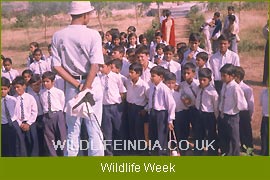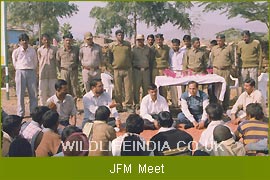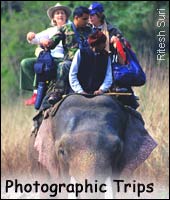| Home : About Us : Contact Us : Commendations : Booking : Email Us |
HOME : Wildlife Conservation
WILDLIFE CONSERVATION


'The Biodiversity Conservation Trust of India OR BCTI was founded in July 2002
as a public charitable Trust and registered under the Indian Trust Act, 1882. It has following objectives -
To promote the ecological security of society.
To provide for secular management of the country's precious biodiversity.
To strive for protection of the environment.
To assist forest dependent communities to co-exist.
Biodiversity Conservation Trust of India has been actively involved in the Kuno Wildlife Sanctuary of M.P. that is proposed second home for the Asiatic lions since its formation.
At present, Gir National Park and Sanctuary in Gujrat is the Asiatic lion's last resort in the world. A small population of the big cats represents an extremely restricted population distribution; this leaves them vulnerable to variety of extinction threats like epidemic, diseases and other natural calamities.
With a view to prevent the extinction of the Asiatic lions, the Wildlife Institute of India conducted a survey in search of a new home for the big cat. The Kuno wildlife Sanctuary in the northwest Madhya Pradesh was finally selected as the site to establish a second free ranging population of this mega carnivore.
BCTI initiated its work in association with the forest department at and around the Kuno wildlife Sanctuary. BCTI has been involved with the rehabilitation of 24 villages from within the Sanctuary to create a human free environment for the lions.
BCTI Activities

1. Regular interaction with the villagers:
The BCTI has been interacting with the rehabilitated villages as well as surrounding villages of the Sanctuary on the regular basis for information decimation on various issues ranging from agriculture, drinking water and watershed development and management. Special attention are being given on agriculture in which rehabilitated villagers are being informed on the importance of crop selection, weed removal seed selection etc.
2.Technical support:
BCTI has been giving technical support to the different developmental activities initiated by the forest department at the rehabilitation site as well as in the peripheral villages.
3.Wildlife Week:
The lion reintroduction
 program is in progress with therehabilitation of all the 24 villages from within
the Kuno Wildlife Sanctuary (KWS). The forest department has been doing everything
with their small staff base. Therefore, Biodiversity Conservation Trust of India
extended its support to the Forest Department for the mass awareness program
during the wildlife week. It is being done in the first week of October every
year in the surrounding areas keeping students, teachers, village panchayat
heads and elders and the government officials as a target group. Slide shows,
films, painting and quiz competitions are organized on wildlife conservation
theme.
program is in progress with therehabilitation of all the 24 villages from within
the Kuno Wildlife Sanctuary (KWS). The forest department has been doing everything
with their small staff base. Therefore, Biodiversity Conservation Trust of India
extended its support to the Forest Department for the mass awareness program
during the wildlife week. It is being done in the first week of October every
year in the surrounding areas keeping students, teachers, village panchayat
heads and elders and the government officials as a target group. Slide shows,
films, painting and quiz competitions are organized on wildlife conservation
theme. 4. Training on Joint Forest management:
Conducted workshop/training program for the frontline staff and Chairperson, Secretary and members of Forest Protection Committee & Village Forest Committee of Kuno wildlife Division and Sheopur Forest Division. This was organized every month for 7-8 days from October 2002 to January2003 in association with the forest department. Aim of the training was to involve villagers into forest conservation, which in turns bring them benefits.
Wildlife Mass Awareness Campaign
A systematic awareness campaign was also initiated to prepare neighborhood communities to live with a mega carnivore like lion- an animal that they never encountered before.
 This
campaign was initiated at various places from March-April 2003 in association
with the Sanctuary management and the Biodiversity Conservation Trust of India
(BCTI) in which information on the lion reintroduction program has been given.
Exclusive slide shows were given at various places during this campaign in which
stress has been given to reduce the number of cattle. It was tried to convince
the community with the help of slides that a healthy population of big cats
in the neighboring forest helps community with the increased water level in
their wells as well as increased soil moisture content in their agricultural
fields.
This
campaign was initiated at various places from March-April 2003 in association
with the Sanctuary management and the Biodiversity Conservation Trust of India
(BCTI) in which information on the lion reintroduction program has been given.
Exclusive slide shows were given at various places during this campaign in which
stress has been given to reduce the number of cattle. It was tried to convince
the community with the help of slides that a healthy population of big cats
in the neighboring forest helps community with the increased water level in
their wells as well as increased soil moisture content in their agricultural
fields.5. Preparing Microplan:
BCTI is presently involved in the micoplan preparation of the rehabilitated as well as adjoining villages in association with the forest department.
The microplan would act as a blue print of the village development. It would help the implementing agencies in finding out developmental initiatives at the village level according to the priority fixed by the villagers through micoplans BCTI intended to work in the buffer areas including rehabilitation site on cattle management issues, which would ultimately reduce the grazing pressure on the sanctuary and other eco-development aspect.
.......................................................................................................................................................................................
More About Tiger Conservation Activities visit :
www.saveindiastigers.co.uk
.......................................................................................................................................................................................



